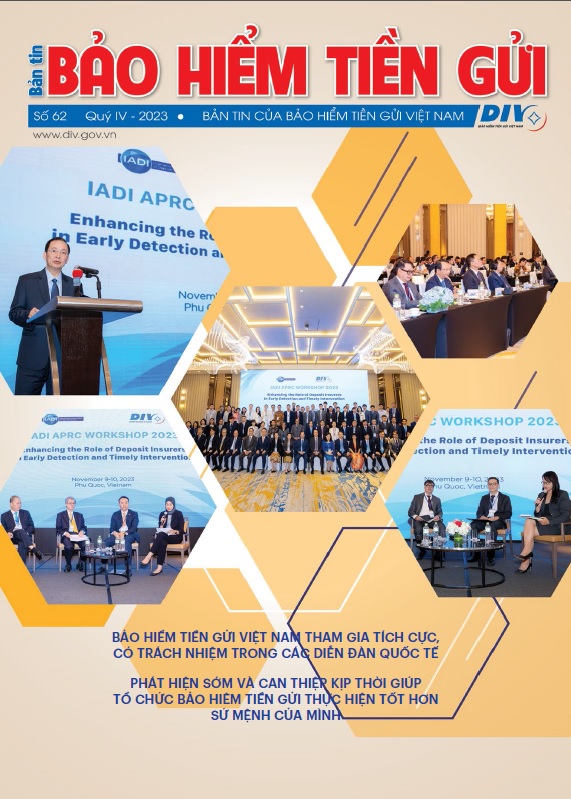According to the Law on Deposit Insurance, insured institutions and deposit insurers shall take responsibilities for I.E.C (Information-Education-Communication) activities, keeping people informed of interests, providing them with guidance and supports on how to prepare procedures most quickly to enjoy the benefits of deposit insurance. Clause 3 of Article 11, the Law on Deposit Insurance stipulates “To require insured institutions and the deposit insurance organization to provide adequate, accurate information regarding deposit insurance.”
Priority problems of depositors in deposit insurance policies are often information of depository institutions that has participated in deposit insurance and information of insured deposits, especially types of insured deposits and insurance coverage limits. Such information should be publicized explicitly and transparently to the depositors.
Information of depository institution participating in DI
There are quite few different information. The most important thing is how depositors can access to this kind of information easily with most updated news. Apart from public awareness programs and announcements publicized on the mass media such as radio, newspapers, TV, websites..., official announcement of participation or non-participation should be made listed, posted in office of insured institutions.
Article 15 of the Law on Deposit Insurance stipulates "Insured institutions shall publicly display copies of certificate of deposit insurance participation at all business offices accepting deposits.” By this way, depositors can access information directly about depository institution that they plan to deposits in it.
Information of insured deposit
Information of insured deposits includes contents of: (i) type of insured deposits, and (ii) insurance coverage limits. It is suggested regulations on insured deposits should be consistent with those on deposits as prescribed in other applicable laws and regulations related to banking activities. Specific and exact information of insured deposits shall reduce inconsistency and exposure to conflicts that may occur in case of insured institution closure. Both insured institutions and deposit insurance organization must take responsibility for keeping public, especially depositors informed of types of insured deposits and insurance coverage limit. Depositors have rights to know such information in order to ask for protection of their legitimate interests in case of bank closure. At the same time, specific regulations on such information also aim to better control moral hazard that may occur in banking and deposit insurance operations.
(i) Types of insured deposits
It is explicit that not all types of deposits with insured institutions of depositors are covered. Thus, a part from keeping public informed of depository institutions participating in deposit insurance, one information that attracts interests of depositors is which type of deposits is insured and which one is not. Public in general and depositors in particular will feel assured their deposits are insured, helping them to deposit their money instead of investing in other investments.
Determining which type of deposits is insured and which one is not depends on monetary policy, development level of the banking system and economic growth of each country. In order to reflect public policy objectives, most countries have specific regulations on that.
The very regulation is very important and necessary as it relates directly to the determination of depositors under protection of deposit insurance policies through insurance coverage payment and deposit insurance premium assessment.
Most deposit insurance organizations in the world insure their domestic currency, while do not cover foreign currencies and gold. Ordinance on foreign exchange also stipulates deposit insurance on compulsory domestic currency. At present, Vietnam economy has been negatively influenced by dollarization and goldization. The provisions of law stipulate a compulsory deposit insurance mechanism for domestic currency, aiming at preventing from dollarization.
Article 18 of the Law on Deposit Insurance stipulates: "Insured deposits are deposits in Vietnamese Dong of individuals with insured institutions in the forms of time deposits, demand deposits, savings accounts, certificates of deposit, bills, notes and other types of deposits as stipulated in the Law on credit institutions”, except cases prescribed in the Decree.
According to the broader perspective of deposit insurance in the world and in order to prevent from moral hazard, the law on deposit insurance law speculates that no insurance for those who directly or indirectly decide their business in depository institutions.
In the term of that, in order to bring this kind of information to depositors in a simple, efficient and most accurate manner, a research by Garcia (1999) and researchers in the US on deposit insurance has recommended insured institutions stamping on prints – a tool used to mobilize deposit - the content saying that deposits are insured in accordance with the provisions of laws or vice versa [2]. This helps clients identify the most accurately type of deposits, ways of depositing their money that can be covered or not. In Vietnam, some banks have also kept their customers informed of this content in the form of stamp on the customer's deposit book.
ii) Insurance coverage limits
Reimbursement of insurance coverage limits is to implement payment commitments of insured deposits, including principal and interests under a certain level as prescribed by deposit insurance organizations to depositors eligible for insurance, upon provisions on insurance coverage limits made by each deposit insurance system. Insurance coverage limits are the easiest recognized affirmation about interests of insured depositors.
Insurance coverage limits are the core issue of deposit insurance operation. Insurance coverage limits depend on many factors, but generally replies on the following basic elements: Gross Domestic Product (GDP) per capita; size of deposit insurance fund... Insurance coverage limit is flexibly adjusted according to the situation of socio-economic stability. Insurance coverage limit should be explicitly publicized to the depositors. Depositors need to access to accurate, complete information on insurance coverage limit, in order to ask for protection in case of deposit insurance obligation arising.
Insurance coverage limit in Vietnam is now 50 million VND, which were adjusted in 2005 from $30 million upon the introduction of the deposit insurance system in Vietnam in 2000. This coverage limit is regarded as being consistent with international practice at the time of instruction of the deposit insurance system, which was equivalent to 5.5 times more than the average GDP per capita in 2005 and could protect the whole account of about 80% of the depositors in case of bankruptcy, dissolution, in comparison with about 3-12 times more than the average GDP of the world. According to the Law on Deposit Insurance, insurance coverage limit shall be decided by the Prime Minister at request of the State Bank of Vietnam in each period [3].
In addition, timely and convenient reimbursement made to depositors shall help them feel assured of, trust in the banking system in general, minimizing systematic crisis. The Law on Deposit Insurance stipulates: "Within 60 days of the date when insurance payment duty arises, the deposit insurance organization shall be obliged to make insurance payment to the insured depositors." [3].
Deposit Insurance is a policy tool to protect the interests of depositors. Therefore, it is important and necessary to keep depositors informed of information relating to their interests, especially amid the volatile financial and monetary situation.
References :
[1] FDIC, Household Survey on Deposit Insurance Awareness, 2001, Survey Report
[2] Garcia G. (2000), Deposit Insurance and Crisis Management
[3] Quốc hội nước CHXHCN Việt Nam, 2012, Luật Bảo hiểm tiền gửi.
[4] Vũ Minh Trà, 11/11/2011, Bảo hiểm tiền gửi trên thế giới và Việt Nam, http://pgbankresearch.wordpress.com
[6] www.div.gov.vn
[7] www.fdic.gov
[8] www.cdic.gov.tw

























